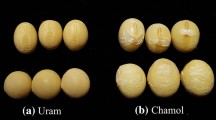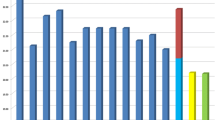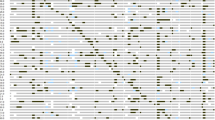Abstract
Seed coat cracking (SCC) consists of irregular cracks on the surface of seed coat, giving rise to serious effects on the seed quality in soybeans. However, breeding to achieve resistance to SCC has been an arduous task due to the complicated genetic behavior and environmental interactions. Thus, this study aims to map quantitative trait loci (QTLs) controlling irregular SCC in soybeans and to study QTL-by-environment interactions. QTL analysis was conducted using an RIL population derived from Keunolkong × Sinpaldalkong. The SCC was determined at natural conditions and calculated three times by counting cracked seeds with a 100 seeds per plant basis. In the four environments, a total of 10 QTLs with additive effects were identified. Among them, three QTLs (qSCC2-1, qSCC9, and qSCC20) located on chromosomes 2, 9, and 20 showed main-additive effects explaining 9.5–19.4 % of phenotypic variances in two environments. Across environments, seven additive QTLs, four additive × environment (AE) interactions, and two pairs of epistatic QTLs and epistasis × environment interactions were identified for SCC. Similar to the results in individual environments, two major QTLs (qSCC2-1 and qSCC9) showed additive main effects explaining 10.5 and 6.5 % of phenotypic variances, respectively and significant AE interaction in 2006 Suwon. The total QTLs explained 48.0 % of the phenotypic variation, with additive effects of 33.8 %, epistatic effects of 7.6 %, and AE and AAE of 6.6 %. All in all, these results showed that both additive effects and AE interactions can serve as important genetic basis for SCC.


Similar content being viewed by others
References
Benitez ER, Funatsuki H, Kaneko Y, Matsuzawa Y, Bang SW, Takahashi R (2004) Soybean maturity gene effects on seed coat pigmentation and cracking in response to low temperatures. Crop Sci 44:2038–2042
Burchett CA, Schapaugh WT, Overley CB, Walter TL (1985) Influence of etched seed coats and environmental conditions on soybean seed quality. Crop Sci 25:655–660
Collard BCY, Mackill DJ (2008) Marker-assisted selection: an approach for precision plant breeding in the twenty-first century. Philos Trans R Soc B 363:557–572
Duke SH, Kakefuda G, Henson CA, Loeffler NL, Van Hulle NM (1986) Role of the testa epidermis in the leakage of intracellular substances from imbibing soybean seeds and its implications for seedling survival. Physiol Plant 68:625–631
Hong EH, Kim SD, Lee YH, Hwang YH, Moon YH, Kim HS, Park EH, Seong YG, Kim YH, Kim WH, Ryu YH, Park RK (1992) A good quality, semi-dwarf, high density adaptable and high yielding new soybean variety “Sinpaldalkong”. RDA J Agric Sci 34(2):20–25
Kang S-T, Kwak M, Kim H-K, Choung M-G, Han W-Y, Baek I-Y, Kim M, Van K, Lee S-H (2009) Population-specific QTLs and their different epistatic interactions for pod dehiscence in soybean [Glycine max (L.) Merr.]. Euphytica 166:15–24
Keim P, Olson TC, Shoemaker RC (1988) A rapid protocol for isolating soybean DNA. Soybean Genet Newsl 15:150–154
Kim HK, Kang ST, Suh DY (2005) Analysis of quantitative trait loci associated with leaflet types in two recombinant inbred lines of soybean. Plant Breeding 124:582–589
Korir PC, Qi B, Wang Y, Zhao T, Yu D, Chen S, Gai J (2011) A study on relative importance of additive, epistasis and unmapped QTL for aluminium tolerance at seedling stage in soybean. Plant Breed 130:551–562
Kosambi DD (1944) The estimation of map distances from recombination values. Ann Eugen 12:172–175
Lande R (1992) Marker-assisted selection in relation to traditional methods of plant breeding. In: Stalker HT, Murphy JP (eds) Plant breeding in the 1990s. C.A.B. International, Wallingford, pp 437–451
Liu HL (1949) Inheritance of defective seed coat in soybean. J Hered 40:317–322
Manly KF, Cudmore JRH, Meer JM (2001) Map Manager QTX, cross-platform software for genetic mapping. Mamm Genome 12:930–932
Mohan A, Kulwal P, Singh R, Kumar V, Mir R, Kumar J, Prasad M, Balyan H, Gupta P (2009) Genome-wide QTL analysis for pre-harvest sprouting tolerance in bread wheat. Euphytica 168:319–329
Molnar SJ, Rai S, Charette M, Cober ER (2003) Simple sequence repeat (SSR) markers linked to E1, E3, E4, and E7 maturity genes in soybean. Genome 46:1024–1036
Nakamura T, Yang D, Kalaiselvi S, Uematsu Y, Takahashi R (2003) Genetic analysis of net-like cracking in soybean seed coats. Euphytica 133:179–184
Nicholas CD, Lindstrom JT, Vodkin LO (1993) Variation of proline rich cell wall proteins in soybean lines with anthocyanin mutations. Plant Mol Biol 21:145–156
Oyoo ME, Benitez ER, Matsumura H, Takahashi R (2010a) QTL analysis of seed coat cracking in soybean. Crop Sci 50:1230–1235
Oyoo ME, Githiri SM, Benitez ER, Takahashi R (2010b) QTL analysis of net-like cracking in soybean seed coats. Breed Sci 60:28–33
Percy J, Philip R, Vodkin L (1999) A defective seed coat pattern (Net) is correlated with the post-transcriptional abundance of soluble proline-rich cell wall proteins. Plant Mol Biol 40:603–613
Ravi K, Vadez V, Isobe S, Mir R, Guo Y, Nigam S, Gowda M, Radhakrishnan T, Bertioli D, Knapp S, Varshney R (2011) Identification of several small main-effect QTLs and a large number of epistatic QTLs for drought tolerance related traits in groundnut (Arachis hypogaea L.). Theor Appl Genet 122:1119–1132
Shen X, Zhang T, Guo W, Zhu X, Zhang X (2006) Mapping fiber and yield QTLs with main, epistatic, and QTL × environment interaction effects in recombinant inbred lines of upland cotton. Crop Sci 46:61–66
Srinivasan A, Arihara J (1994) Soybean seed discoloration and cracking in response to low temperatures during early reproductive growth. Crop Sci 34:1611–1617
Suh HS, Shin IY, Baek IY, Park CK, Kim YC, Lee JM, Lee SK (1992) A new high yielding summer soybean variety “Keunolkong”. RDA J Agric Sci 34(2):16–19
Takahashi R (1997) Association of soybean genes I and T with low-temperature induced seed coat deterioration. Crop Sci 37:1755–1759
Takahashi R, Abe J (1999) Soybean maturity genes associated with seed coat pigmentation and cracking in response to low temperatures. Crop Sci 39:1657–1662
Takahashi R, Asanuma S (1996) Association of T gene with chilling tolerance in soybean. Crop Sci 36:559–562
Wang C, Chen Y, Ku L, Wang T, Sun Z, Cheng F, Wu L (2010) Mapping QTL associated with photoperiod sensitivity and assessing the importance of QTL × environment interaction for flowering time in maize. PLoS ONE 5:e14068
Wang S, Basten CJ, Zeng ZB (2011) Windows QTL cartographer 2.5. Department of Statistics, North Carolina State University, Raleigh
Watanabe S, Hideshima R, Xia Z, Tsubokura Y, Sato S, Nakamoto Y, Yamanaka N, Takahashi R, Ishimoto M, Anai T, Tabata S, Harada K (2009) Map-based cloning of the gene associated with the soybean maturity locus E3. Genetics 182:1251–1262
Yaklich RW, Barla-Szabo G (1993) Seed coat cracking in soybean. Crop Sci 33:1016–1019
Yang J, Zhu J (2005) Methods for predicting superior genotypes under multiple environments based on QTL effects. Theor Appl Genet 110:1268–1274
Yang D, Nakamura T, Ohtsubo N, Takahashi K, Abe J, Takahashi R (2002) Seed coat cracking in soybean isolines for pubescence color and maturity. Crop Sci 42:71–75
Yang J, Hu C, Hu H, Yu R, Xia Z, Ye X, Zhu J (2008) QTLNetwork: mapping and visualizing genetic architecture of complex traits in experimental populations. Bioinformatics 24:721–723
Yang K, Jeong N, Moon J-K, Lee Y-H, Lee S-H, Kim HM, Hwang CH, Back K, Palmer RG, Jeong S-C (2010) Genetic analysis of genes controlling natural variation of seed coat and flower colors in soybean. J Hered 101:757–768
Yu JB, Bai GH, Zhou WC, Dong YH, Kolb FL (2007) Quantitative trait loci for Fusarium head blight resistance in a recombinant inbred population of Wangshuibai/Wheaton. Phytopathology 98:87–94
Zeng G, Li D, Han Y, Teng W, Wang J, Qiu L, Li W (2009) Identification of QTL underlying isoflavone contents in soybean seeds among multiple environments. Theor Appl Genet 118:1455–1463
Acknowledgments
The present research was funded by the Rural Development administration (RDA), Republic of Korea. Also this research was supported by Bio-industry Technology Development Program (Code No. 111114-01-1-SB010), Ministry for Food, Agriculture, Forestry and Fisheries, Republic of Korea.
Author information
Authors and Affiliations
Corresponding author
Rights and permissions
About this article
Cite this article
Ha, BK., Kim, HK. & Kang, ST. Mapping QTLs with epistatic effects and QTL-by-environment interactions for seed coat cracking in soybeans. Euphytica 186, 933–942 (2012). https://doi.org/10.1007/s10681-012-0719-8
Received:
Accepted:
Published:
Issue Date:
DOI: https://doi.org/10.1007/s10681-012-0719-8




